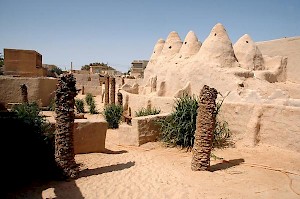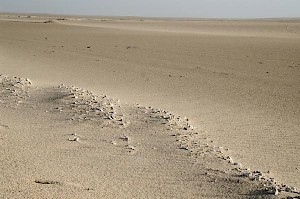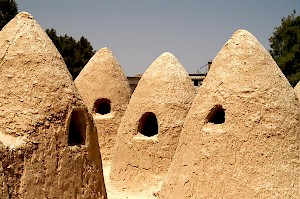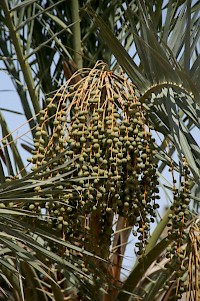The Nasamones of Awjila
Q1215696Nasamones: nomadic tribe from ancient Libya, migrating between the Syrtis Major and the Awjila oasis.

The Nasamones are mentioned by several ancient authors. Writing in the fifth century BCE, the Greek researcher Herodotus of Halicarnassus records that they were nomads from Libya, who were living on the shores of the Gulf of Syrtis Major and in an oasis called Augila (modern Awjila). This region, Strabo of Amasia writes,
resembles the oasis of Siwa, being productive of palm-trees and also well supplied with water. It lies above Cyrene to the south, and for a distance of 175 km produces trees, but for another 175 the land is only sown, although, on account of its aridity, the land does not grow rice.note

Herodotus informs us that the Nasamones visited the oracle of Ammon in Siwa and knew how to cross the Sahara, where they had contacts with the Pygmies.note This suggests a role in the trans-Saharan trade. However, Herodotus has a lot more to tell about the Nasamones:
They are a numerous race, who in the summer leave their flocks behind by the sea and go up to the region of Augila to gather the fruit of the date-palms, which grow in great numbers and very large and are all fruit-bearing: they hunt the wingless locusts, and they dry them in the sun and then pound them up, and after that they sprinkle them upon milk and drink them.
Their custom is for each man to have many wives, and they make their intercourse with them common in nearly the same manner as the Massagetes, that is they set up a staff in front of the door and so have intercourse. When a Nasamonian man marries his first wife, the custom is for the bride on the first night to go through the whole number of the guests having intercourse with them, and each man when he has lain with her gives a gift, whatsoever he has brought with him from his house.
The forms of oath and of divination which they use are as follows: they swear by the men among themselves who are reported to have been the most righteous and brave, by these, I say, laying hands upon their tombs; and they divine by visiting the sepulchral mounds of their ancestors and lying down to sleep upon them after having prayed; and whatsoever thing the man sees in his dream, this he accepts. They practice also the exchange of pledges in the following manner, that is to say, one gives the other to drink from his hand, and drinks himself from the hand of the other; and if they have no liquid, they take of the dust from the ground and lick it.
[...] The Nasamones bury bodies in a sitting posture, taking care at the moment when the man expires to place him sitting and not to let him die lying down on his back.
They have dwellings composed of the stems of asphodel entwined with rushes, and so made that they can be carried about.note

Sometimes, the Nasamones threatened the Greek towns of the Cyrenaica. It is known that during the Peloponnesian War, the Spartan commander Gylippus, who was on his way to Sicily, paid a visit to the Greek town of Euesperides and defended it against a native tribe, which can only have been the Nasamones.note One wonders what this battle must have looked like, because the Spartans were hoplites and the Libyan tribesmen used to fight from chariots. Another war is mentioned by the Roman author Pliny the Elder, who writes that the Nasamones expelled the Psylli, another tribe on the shores of the Syrtis Major.note

The emperor Augustus tried to pacify the tribes of the desert. In c.20, a general named Lucius Cornelius Balbus left the Tripolitanian town Sabratha and reached Germa, the capital of another tribe, the Garamantes, living in what is now called the Fezzan. Five years later, in 15 BCE, a proconsul named Publius Sulpicius Quirinius (who is better known from his governorship of Syria, which coincided with the birth of Jesus of Nazareth), subjected the Nasamones. Yet, they kept some of their independence. A century later, a praetor named Gnaeus Suellius Flaccus defeated them again and pushed them away from the coast into the interior. Cassius Dio writes:
Many of the peoples tributary to the Romans revolted when contributions of money were forcibly extorted from them; among these were the Nasamones. They massacred all the tax collectors and so completely defeated Gnaeus Suellius Flaccus, the governor of Numidia, who proceeded against them, that they even plundered his camp. But having discovered the wine and other provisions there, they gorged themselves and fell asleep, and Flaccus, learning of this, attacked them and annihilated them, even destroying all the non-combatants. [The emperor] Domitian was elated at this success and said to the senate: "I have forbidden the Nasamones to exist."note
This was, of course, exaggerated. However, the fact that the Nasamones are still mentioned on the fourth-century Peutinger map is no evidence for their continued existence, because this map was based on the map by Agrippa, a contemporary of the emperor Augustus.

Archaeological evidence is rare. One would expect a Roman fort in Awjila, but nothing has been identified yet. The remains of a temple of Zeus Ammon were still visible in the nineteenth century. It was still in use in the sixth century, as Procopius tells us:
And there are two cities which are known by the same name, each of them being called Augila. These are distant from Boreium about four days' journey for an unencumbered traveller, and to the south of it; and they are both ancient cities whose inhabitants have preserved the practices of antiquity, for they all were suffering from the disease of polytheism even up to my day. There from ancient times there have been shrines dedicated to Ammon and to Alexander the Macedonian. The natives actually used to make sacrifices to them even up to the reign of Justinian. In this place there was a great throng of those called temple-slaves. But now the Emperor has made provision, not alone for the safety of the persons of his subjects, but he has also made it his concern to save their souls, be thus he has cared in every way for the people living there. Indeed he by no means neglected to take thought for their material interests in an exceptional way, and also he has taught them the doctrine of the true faith, making the whole population Christians and bringing about a transformation of their polluted ancestral customs. Moreover he built for them a Church of the Mother of God to be a guardian of the safety of the cities and of the true faith. So much, then, for this.note